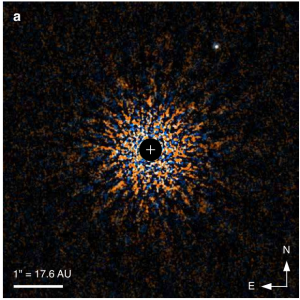
The false-color, infrared image of the GJ 504 system. The star (center) has been blocked out, and the planet appears a white blob at the upper right.
At today’s journal club, we discussed the recent paper Kuzuhara et al. (2013), which reports the discovery of an extrasolar planet with a mass of about 4 times Jupiter’s mass but in an orbit more distant from its sun than Neptune is from ours.
The image at left shows one of the discovery images, taken at infrared wavelengths. At these wavelengths, usually a planetary host star is shining much less brightly than at visible wavelengths, which makes it easier to see radiation from the planet. However, for the kind coronagraphic imaging here, the star still has to be blocked out to prevent the glare from masking the planet (and blocking out the star completely is hard to do, as evidenced by the orange and blue speckles in the image).
This planet is particularly interesting because it is the oldest planet (it’s at least 160 million years old) to be observed with this kind of direct imaging technique. Younger planets are usually hotter and emit more radiation, and so it’s easier to see them when they’re younger.
Although this system is one of the oldest directly imaged, it’s still very young compared to our solar system, which is about 4.5672 billion years old. 160 million years after our Sun formed (and the solar system got its start), the Earth and other planets had already formed, but the Earth was very different from the way it is today. For example, water may have already collected in the oceans, but our atmosphere was probably composed of carbon dioxide and water, with essentially no oxygen. Oxygen came later when life got started.
So studies like this one can allow us to peer back in time to figure out, among other things, what planets look like when they are very young and piece together to story of our solar system.